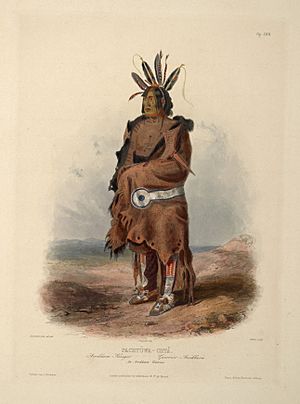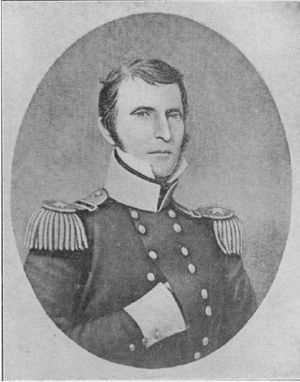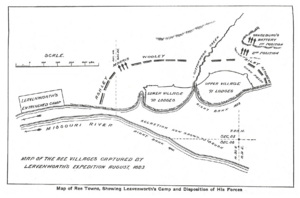Arikara War facts for kids
Quick facts for kids Arikara War |
|||||||
|---|---|---|---|---|---|---|---|
| Part of the American Indian Wars | |||||||
 An Arikara warrior, by artist Karl Bodmer |
|||||||
|
|||||||
| Belligerents | |||||||
Sioux |
Arikara | ||||||
| Commanders and leaders | |||||||
| Chief Grey Eye Chief Little Soldier |
|||||||
| Units involved | |||||||
Missouri Legion
|
Arikara
|
||||||
| Casualties and losses | |||||||
| 12 members of Ashley's company killed Seven people from the Army drowned in Missouri River. |
Likely more than 10 warriors and villagers, among them chief Grey Eye. | ||||||

The Arikara War was a short but important conflict in the summer of 1823. It happened in what is now South Dakota, along the Missouri River. This war involved the United States Army and their allies from the Sioux tribe fighting against the Arikara Native Americans.
It was the first time the U.S. Army fought a war against Native Americans west of the Missouri River. The war started after Arikara warriors attacked American fur trappers. This event was a big problem for the fur trade in the western United States.
Contents
Why the War Started
Early Meetings and Growing Tensions
When explorers Lewis and Clark met the Arikara in 1804, they were friendly. However, things changed over time. In 1806, an Arikara leader died during a trip to the U.S. capital. Many Arikara people thought Americans were responsible for his death.
As more fur trading companies came into the area, the Arikara and white traders met more often. This led to small fights. In early 1823, the Arikara attacked a trading post called Fort Recovery. They killed two traders there.
Arikara and Sioux Conflicts
The Sioux people, including the Yankton, Yanktonai, and Lakota groups, had been fighting the Arikara for a long time. They sometimes had short peace agreements, but these were usually on the Sioux's terms.
The Arikara lived in two villages on the west side of the Missouri River. These villages were made of earth lodges and were protected by strong wooden frames.
The Attack and the War (1823)
Trappers Attacked
On June 2, 1823, Arikara warriors attacked trappers working for General William Henry Ashley's Rocky Mountain Fur Company. This happened on the Missouri River. About 15 trappers were killed. The trappers who survived escaped down the river. They hid for over a month.
The U.S. Army Responds
The United States decided to act. They formed a fighting group called the "Missouri Legion." This group included 230 soldiers from the 6th Infantry. It also had 750 Sioux warriors and 50 fur trappers. Lieutenant Colonel Henry Leavenworth led this force from Fort Atkinson, which is in present-day Nebraska.
The Sioux warriors were from different groups like the Yankton, Yanktonai, Brule, Blackfeet, and Hunkpapa. They wanted to join the fight. They were promised Arikara horses and valuable goods if they won. Also, new hunting grounds would open up for the Sioux if the Arikara villages were defeated.
The Battle at the Villages
On August 9, 1823, Leavenworth and his forces arrived at the Arikara villages. They started their attack with Sioux cavalry, but the Arikara fought them off.
The next day, August 10, Leavenworth ordered his artillery to fire cannons at the villages. The shots mostly missed, landing beyond the villages. So, Leavenworth ordered his infantry soldiers to attack. Like the Sioux, the regular soldiers could not break into the villages. They left the area with some captured horses and corn from the Arikara fields.
Peace and Aftermath
On August 11, 1823, Leavenworth tried to make a peace treaty with the Arikara. He faced many problems from the Missouri Fur Company, who did not want peace.
Fearing more attacks, the Arikara left their villages that night. Leavenworth started his journey back to Fort Atkinson on August 15. After he left, members of the Missouri Fur Company burned the Arikara village. This made Leavenworth very angry.
The U.S. Army had its first casualties in the West during this war. Seven soldiers drowned in the Missouri River.
Why the War Happened
The exact reasons for the war are not fully known. However, the way the Arikara traded with white traders was a big part of it.
Arikara's Trading Role
The Arikara lived in permanent villages for most of the year. They farmed, fished, and hunted buffalo. But this was not enough for them to survive. They also needed to trade with other tribes to get what they needed. They were important middlemen in the trade network.
When Ashley's expedition came to buy furs directly, it cut out the Arikara's role as traders. This was a direct threat to how they made a living.
Desire for a Trading Post
The Arikara also wanted a trading post on their own land. This would give them easy access to manufactured goods. They were upset that their enemies, the Sioux, had such posts, but they did not.
Ashley had been asked to set up a trading post in 1822. He promised to ship goods from St. Louis directly to them. However, he never kept this promise by the time of his 1823 trip.
Other Resentments
Another reason for bad feelings was the death of the Arikara chief Ankedoucharo in 1806. He died during a visit to Washington. Even though he died of natural causes, many Arikara believed he was murdered.
After the Arikara village was destroyed on June 2, some Americans blamed the Hudson's Bay Company. They thought the company was stirring up the Arikara to hurt American fur trade. However, the Hudson's Bay Company said they had no trappers in that area.
What Happened Next
Arikara Return and Peace
The Arikara people who had left their homes returned the next spring. They rebuilt their villages.
The fighting between the United States and the Arikara officially ended on July 18, 1825. They signed a peace treaty. The U.S. Army and the Arikara never fought each other again.
Sioux and the Arikara
For the Sioux, the war made them lose trust in white people. The Sioux continued to attack the Arikara and push them north. In 1851, the western Sioux claimed the 1823 battleground as their land. They later received official recognition for this land in the Treaty of Fort Laramie.
Lasting Impact
Even though the Arikara War was short, it was important for two reasons:
- It was the first military conflict between the U.S. and Native Americans in the West. It set the stage for future encounters.
- Leavenworth did not completely defeat the Arikara. His decision to be lenient caused a big debate among white Americans. Some wanted to control Native Americans, while others wanted peaceful living.
The Arikara eventually settled with the Mandan and Hidatsa tribes. They moved to the Fort Berthold Reservation in North Dakota. Many Arikara and Crow people later became Indian scouts during the Sioux Wars.
In 1932, archaeologists explored the old Arikara village site. They found unexploded cannon shells hidden in the ground. This showed how the artillery attack more than 100 years earlier had not been very effective.
In the Media
A made-up version of the 1823 Arikara attack on the Rocky Mountain Fur Company is shown in the 2015 movie The Revenant. It tells the story from the point of view of a trapper named Hugh Glass.
See Also
Images for kids
-
Cloud-Shield's winter count (Lakota) showing the Arikara War.



